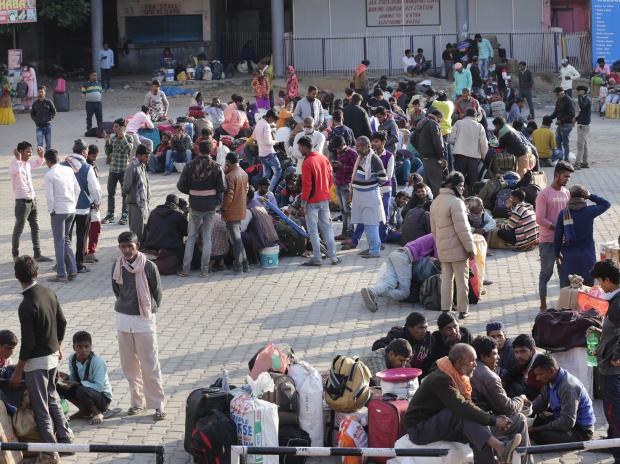28 Kashmir Trains Suspended: How Rail Disruption Is Hurting Passengers, Students & Traders in Jammu and Kashmir
By: Javid Amin | 05 October 2025
When the Tracks Go Silent
For most regions, a train suspension is a temporary inconvenience.
In Jammu & Kashmir, it’s a crisis.
Three weeks into the suspension of 28 crucial train services across the Union Territory, the silence along the tracks from Baramulla to Banihal and Jammu to Katra tells a larger story — one of disrupted lives, broken connectivity, and rising public frustration.
What was initially announced as a short-term security and maintenance measure has now snowballed into an indefinite paralysis, leaving thousands of commuters, students, and small traders stranded daily.
“Railways were our lifeline — safe, fast, and affordable. Now, everything feels disconnected,” said Mehak Jan, a college student from Bijbehara.
For Kashmir, where road travel is often hindered by landslides, security checks, or weather closures, the train network has long been a symbol of stability and connection. Its absence has amplified both logistical and emotional isolation.
What’s Affected: A Valley Cut in Half
According to Northern Railway officials, the suspended services include:
-
Baramulla–Banihal DEMU trains – the main north-south artery of Kashmir.
-
Srinagar–Anantnag–Qazigund routes – key daily commuter lines.
-
Jammu–Udhampur–Katra passenger trains – vital for pilgrims and local traders.
-
Inter-district connectors – essential for school, market, and hospital access.
The impact is uneven yet universal:
-
South Kashmir commuters have been hardest hit — particularly in Pulwama, Shopian, and Anantnag districts.
-
Students who relied on the early-morning trains to reach colleges now face expensive and unpredictable bus journeys.
-
Fruit traders and small vendors find themselves unable to move perishables efficiently.
“We were told the service would resume after a week. It’s been nearly a month,” said Abdul Rashid, a fruit trader from Sopore. “Our goods rot faster than the promises.”
Why the Suspension? Behind the Rail Blockade
The Northern Railway and Railway Protection Force (RPF) cite a combination of reasons for the prolonged suspension:
1. Security Concerns
After stone-pelting incidents near railway tracks in Pulwama and Shopian, the RPF halted operations, citing “risk to passenger and crew safety.”
Incidents of vandalism, though sporadic, have historically triggered blanket suspensions in the Valley.
“Passenger safety is paramount. We will not resume operations until ground conditions are completely stable,” said an RPF official.
2. Track Maintenance Delays
Monsoon-triggered landslides near Qazigund and Banihal have damaged parts of the track.
While repairs began swiftly, the steep terrain and unstable slopes slowed progress.
A senior railway engineer explained, “The Himalayas aren’t forgiving. We deal with daily soil movement, moisture seepage, and loose ballast. Rushing repairs risks derailments.”
3. Operational Constraints
Shortage of train crew and rolling stock has compounded the problem.
Several DEMU rakes and staff were temporarily diverted to northern India for the festival season, reducing available resources for Kashmir’s line.
Combined, these factors created a perfect storm — one that continues to choke the region’s transport backbone.
Passenger Voices: Everyday Struggles, Real Pain
Students Stranded
For many students, trains were not just affordable—they were the only reliable mode of travel.
“I spend ₹60 daily on a train ticket. Now buses cost me ₹150 one way, and they’re always crowded,” said Mehak Jan, a student at the University of Kashmir.
Traders and Daily Wage Workers Hit
Fruit vendors, construction laborers, and small shopkeepers who used trains to move goods or reach workplaces now depend on overpriced shared cabs or erratic buses.
“I used to ship apple crates from Sopore to Anantnag daily. Now, transport costs have doubled,” said Ghulam Nabi, a trader.
Tourists and Pilgrims Inconvenienced
In Jammu, the Jammu–Katra line, which ferries thousands of pilgrims to Vaishno Devi, has also been affected. Local tour operators say the number of daily visitors has dropped by nearly 30%.
“We can’t plan tours or group visits without reliable trains. It affects hotels, restaurants, everyone,” said a travel agent in Katra.
Road Alternatives: Expensive, Overcrowded, Unreliable
The J&K Transport Department rushed to fill the gap with additional buses and mini-coaches on key routes.
However, passengers complain of delays, crowding, and inflated fares.
Private cab operators, sensing opportunity, increased rates by 25–40%, citing “fuel price hikes and extra demand.”
For working-class families, daily travel has turned into an economic burden.
“Earlier, my commute was ₹600 a week. Now it’s nearly ₹1,200,” said a government clerk from Anantnag.
With winter approaching and road conditions worsening, the lack of rail connectivity threatens to further isolate several towns and villages.
Official Silence and Public Anger
Despite growing frustration, no clear restoration timeline has been issued.
The Railway Board has refrained from setting deadlines, while local officials insist they are “reviewing the situation daily.”
“There’s a communication gap between Delhi and the ground,” said a senior official anonymously. “The RPF focuses on safety, but the administration worries about public unrest. Coordination is missing.”
The lack of a transparent public advisory has added to confusion. Even station staff are unsure when operations will resume.
In some areas, abandoned stations like Pampore and Bijbehara now serve as reminders of a halted promise — gleaming platforms without passengers.
The Economic Domino Effect
The suspension isn’t just about inconvenience—it’s an economic wound.
1. Markets Suffer
Traders in Srinagar’s Lal Chowk, Anantnag, and Sopore report falling sales as fewer people travel to urban centers. Footfall in markets is down by nearly 35%, according to local trade associations.
2. Agricultural Losses
The disruption coincides with apple and saffron harvest season. Without trains, shipments face delays, leading to spoilage and higher transport costs.
The Kashmir Valley Fruit Growers Association estimates weekly losses of ₹10–12 crore due to logistical delays.
3. Education Disrupted
Students commuting from Pulwama and Shopian to Srinagar or Awantipora universities face attendance issues. Several colleges report a 20–25% drop in student presence.
4. Tourism Impact
The suspension indirectly impacts tourism perception. Tourists arriving from Jammu often relied on scenic train journeys to reach the Valley. The disruption adds to the sense of logistical instability.
The Bigger Picture: Kashmir’s Rail Network and Its Significance
The Baramulla–Banihal line, inaugurated in phases between 2008 and 2013, was hailed as a symbol of national integration — connecting remote Himalayan valleys to the heart of India.
Covering 137 km, it crosses 42 bridges and 12 tunnels, including the 11 km-long Pir Panjal tunnel, India’s longest.
More than 20,000 passengers used the route daily before the suspension.
Railways were not merely a mode of transport—they became a lifeline for social and economic mobility.
-
Students from remote villages could attend universities.
-
Farmers could transport produce quickly.
-
Traders connected seamlessly with Jammu markets.
-
Tourism expanded beyond Srinagar to smaller towns.
This is why, when trains stop, life itself feels paused.
Can Railways Fix the Mess?
Engineering Challenges
Restoring service isn’t just about clearing tracks—it’s about ensuring stability.
The Qazigund–Banihal section, located in seismic and landslide-prone terrain, requires careful geological assessment.
Security Dynamics
Railways depend on local administration and security forces for safe passage. Any resurgence of unrest or stone-pelting delays resumption.
Coordination Deficit
Railways, RPF, local police, and civil authorities must work in tandem. Experts say bureaucratic silos slow decision-making.
“A joint control cell with local representation could have expedited repair and review,” suggested a retired railway commissioner.
Comparative Lens: How Other Regions Handle Disruptions
Assam & Northeast India
Regular landslides disrupt train lines in Assam and Arunachal Pradesh. Authorities there deploy mobile restoration teams and alternate shuttle services within days.
Maharashtra’s Konkan Line
During monsoons, sections of the Konkan Railway close temporarily, but clear daily restoration bulletins and emergency buses keep public trust intact.
Lesson for Kashmir
Transparency, rapid communication, and local engagement are key.
Kashmir’s passengers feel cut off not just physically but informationally—they don’t know what’s happening next.
The Way Forward: Restoring Trust and Tracks
Experts and civic groups suggest a multi-tier response plan to prevent such long disruptions in future:
-
Public Communication Cell: Daily bulletins on train status, weather, and track safety.
-
Local Workforce Engagement: Hiring trained youth from affected areas for quick-track maintenance.
-
Safety Corridors: Deploying RPF patrols and surveillance cameras near sensitive zones.
-
Alternate Shuttle Services: Short-distance diesel trains or electric trams in safe sectors.
-
Integrated Bus-Rail Ticketing: For seamless transfer in case of partial closures.
-
Stakeholder Consultations: Involving community leaders, traders, and student bodies in planning.
Human Cost: Beyond Numbers
When trains stop, it’s not just schedules that are disrupted—it’s dreams.
Students miss exams. Patients miss hospital appointments. Workers lose wages.
Small towns like Budgam, Pampore, and Qazigund, once lively with morning commuters, now echo with silence.
“We used to hear the whistle at 6:30 every morning,” said Shazia Bano, a teacher from Awantipora. “Now, even the mornings feel empty.”
This psychological disconnect has compounded the sense of isolation already familiar to the people of the Valley.
Bottom-Line: Waiting for the Train and for Accountability
As October unfolds, the rail silence across Jammu & Kashmir continues to grow louder.
What began as a temporary security measure has morphed into a social and economic crisis. The Railway Board’s silence, coupled with slow restoration, risks alienating the very citizens this infrastructure was meant to unite.
Until clear communication and action emerge, passengers remain suspended—between uncertainty and endurance.
“We’re not waiting for luxury,” said a daily commuter from Anantnag. “We’re just waiting for the train — and for someone to care.”




